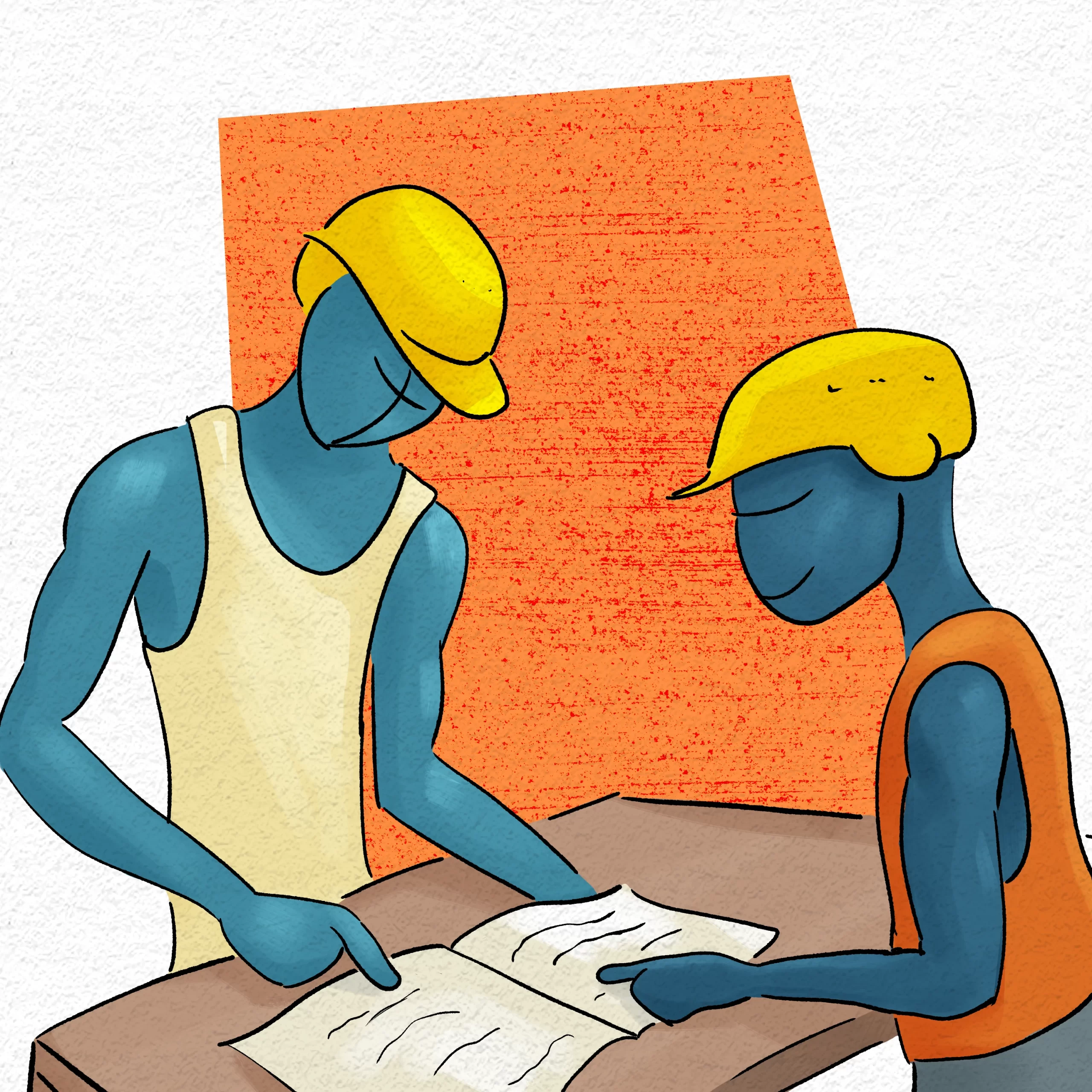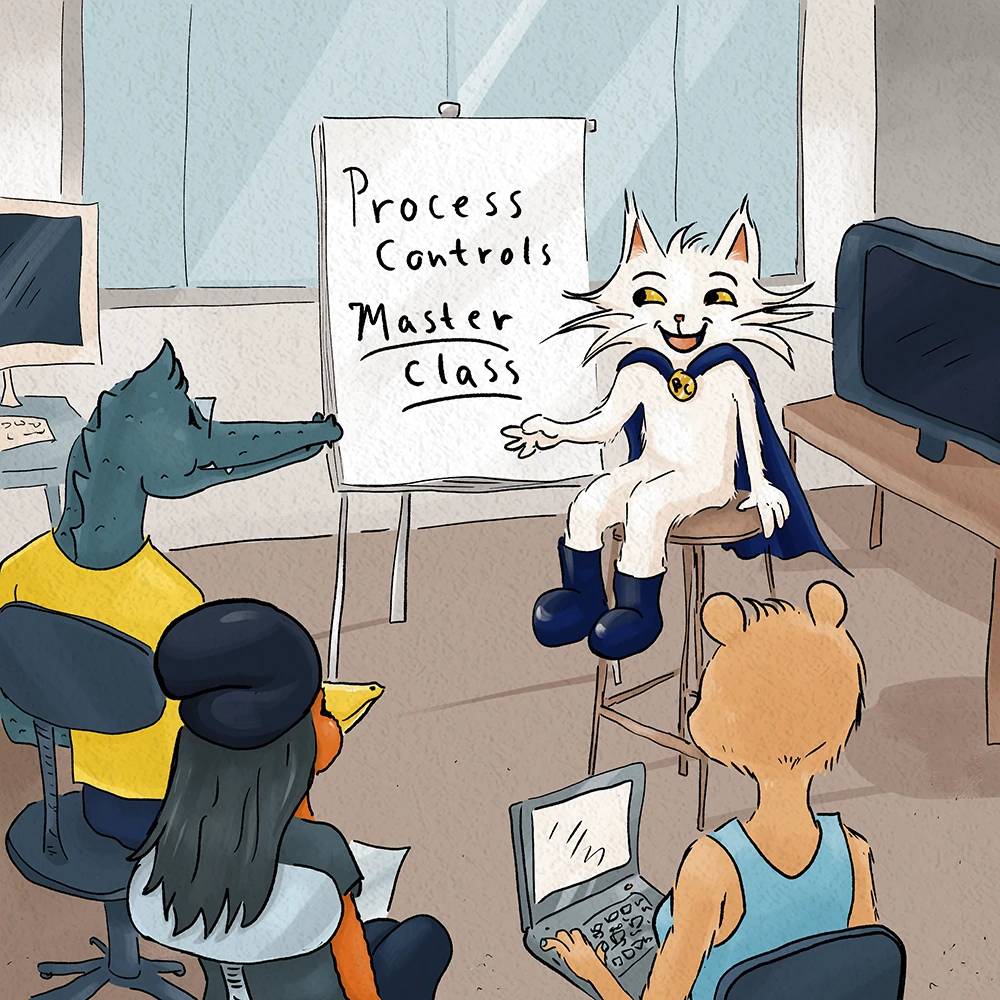
You read our first article on process controls and found it very pedestrian and boring. The information was totally beneath you. (Just kidding, hopefully!) But if you’re ready to learn about process controls from a more academic, and slightly more advanced, perspective, you’re in the right place.
As you know if you’ve been following along, retired nurse Rhonda asked her friend Process Cat for some basic help with controlling her process for making wooden coasters. Since she runs a small operation, Process Cat gave her some quick and actionable advice to solve the problem she actually had, rather than getting into a long lecture about all things process controls.
But Rhonda’s interest in the topic was piqued. And when she talked to her friends Gary and Princess Capybara, they wanted to learn about process controls too. So they all chipped in and rented out a conference room at a local hotel, and convinced their friend Process Cat to teach them a…
Process Controls Master Class!
Process Cat was happy to oblige – he loves any chance to get nerdy and share his knowledge. So he started by showing everyone what “process controls” are:

He explained that this type of drawing is called a block diagram. It shows the conceptual layout of something, often some aspect of a manufacturing process, and it’s not meant to be to scale or in any other way an accurate drawing. It’s all about showing the interactions between different parts of a process.
Anyway, the basic idea of a process control is, there’s a process variable that gets –
Wait, what’s a process variable????
Glad you asked 😉 Here are some examples:

So, there’s a process variable that gets measured by some kind of sensor. (For example, if your process variable is temperature, your sensor would be a thermometer.)
THEN, that sensor sends the information to a controller of some type. The controller then causes some kind of change, either to the same process variable that you measured with the sensor or to something else in the system.
You lied, this process controls stuff is scary
No, no, it’s not once we make it more concrete with an example. In fact, let’s pick one that’s very important in everyday life: the water in your toilet tank!!
Here’s what happens when the level of water in the tank is low:
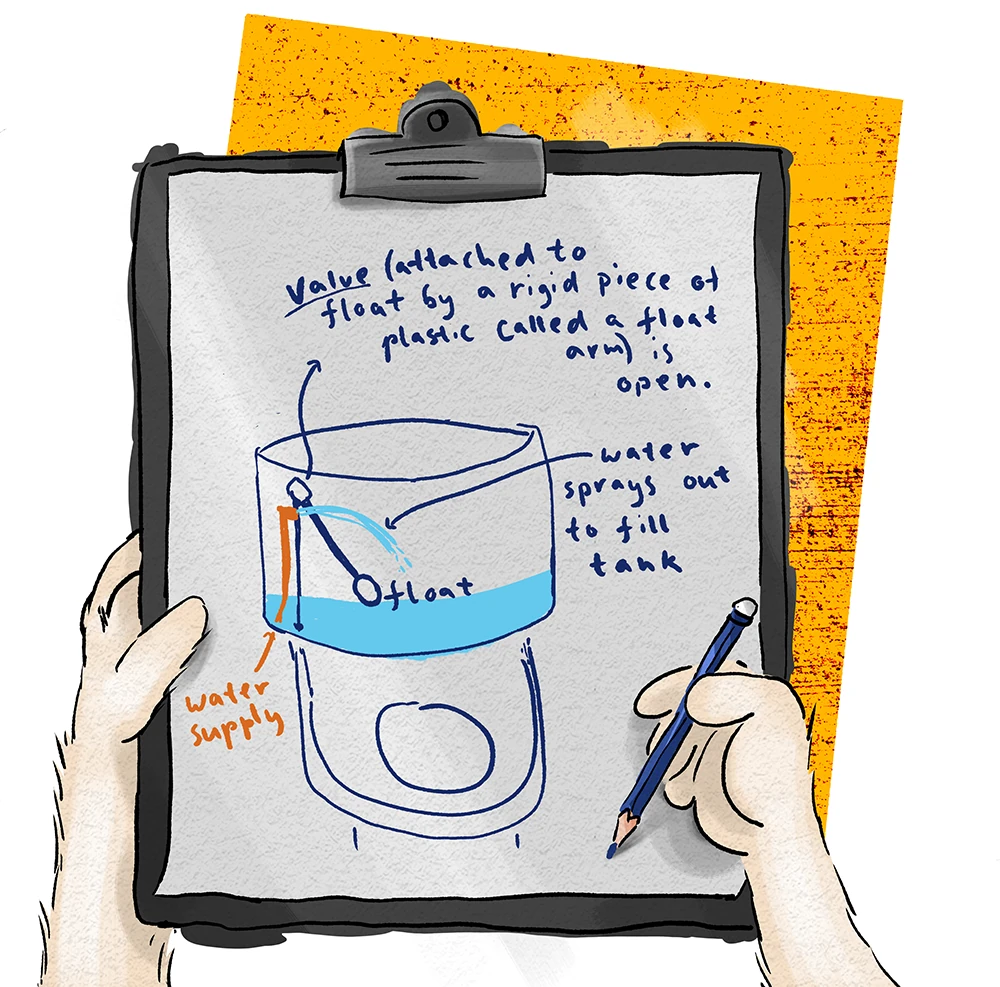
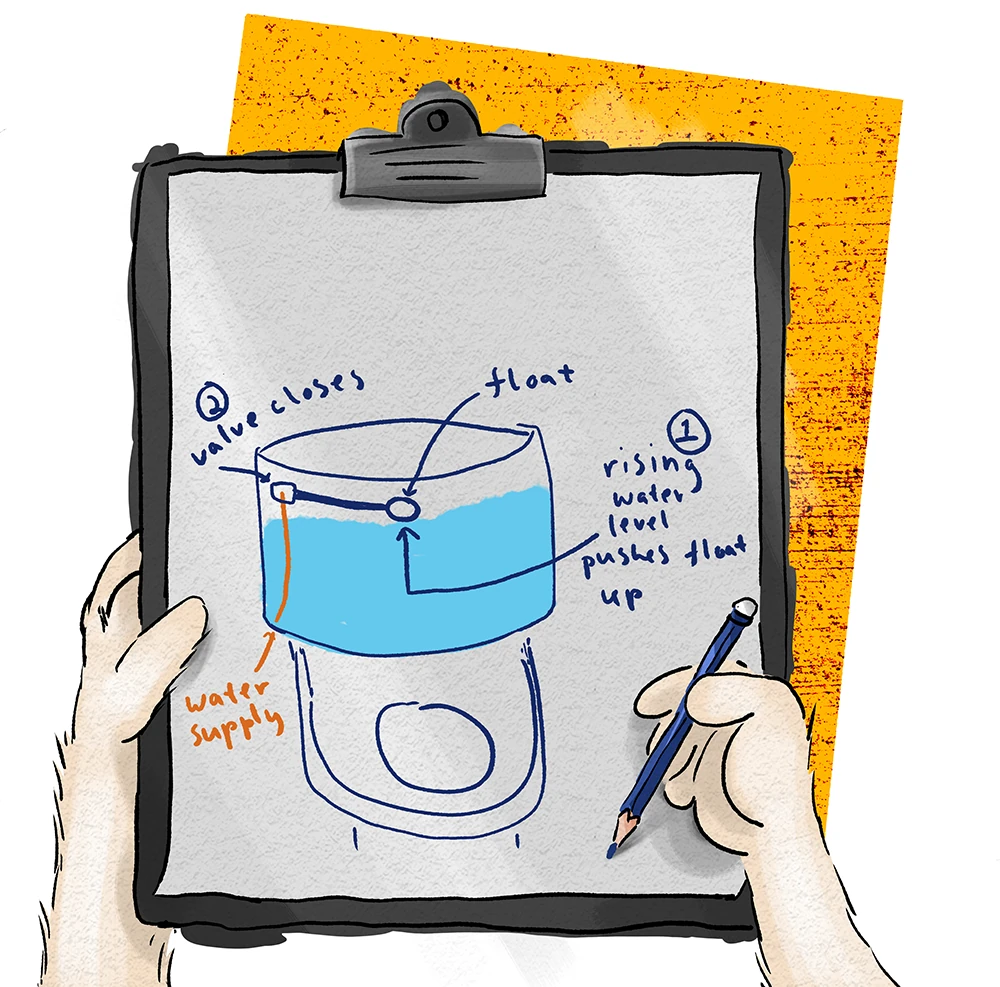
So in this example, the water level in the tank is the process variable. The sensor is the float, which is a plastic ball full of air. (So it naturally floats on top of the water.) The controller is the valve that controls whether or not water is flowing into the tank from the water source. And the variable that is affected by the controller, in this case, is the same as the measured variable – the water level. (More on that in just a minute.)
One other thing to notice: the way the information is sent from the sensor to the controller is by a rigid piece of plastic called the float arm. When the float goes up or down, the float arm pivots. That in turn causes the valve (the controller) to open or close.
In many modern systems, the information is sent in a more complex way, involving encoding the information from the sensor into some kind of digital information that is then used by a computer of one type or another. But it doesn’t have to be!
At this point, Process Cat announced that it was time for a brief coffee break. Knowing that coffee was his favorite beverage, the gang ran across the street and bought him a “large” from the local coffee shop.
And when they returned, Process Cat taught them about…
Continuous Process Controls
Actually, the example of the toilet tank is one of Continuous Process Control. With continuous process control, the variable being measured is also the one being controlled. Continuous process control serves to keep the measured variable within a certain acceptable range. So when the sensor finds that the measured variable is above or below a certain level, it triggers the controller to make a change that brings the measured variable back to the acceptable range.
Besides the toilet tank, another familiar example of a continuous process control is thermostats that keep the temperature in a room at a certain level: the ambient temperature is measured and compared against the temperature that you set. If the temperature gets below a certain level, the heat comes on. If it gets above a certain level, the air conditioning comes on.
There are many, many uses for continuous process controls, in manufacturing processes and elsewhere. But there are also…
Sequential Process Controls
With a sequential process control, once the measured variable gets to a certain level, that triggers the next thing to happen. In other words, it’s a way of automating a process. PCat showed Gary a simple example of a way he could use a sequential process control in his industrial-scale bakery:
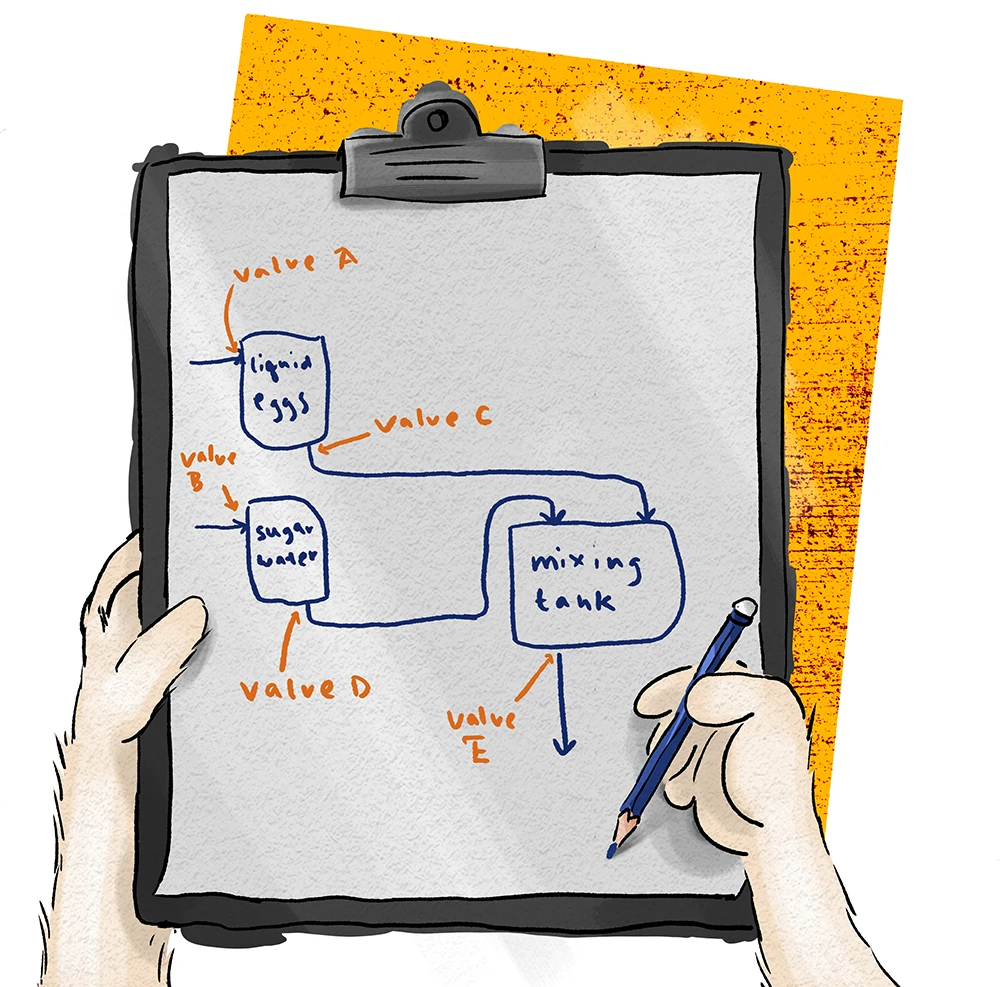
In this example, valves A and B are continuous process controls that let the ingredients in until they reach a certain level, and then stop (just like with the toilet tank.) BUT, once those levels are reached, they trigger valves C and D to open, sending a measured amount of each ingredient to the mixing tank. In this way, precise amounts of eggs and sugar water can be mixed in batches without a human having to measure them! And once a certain amount of time has passed in the mixing tank (remember, time is another process variable), valve E can be triggered to open, sending the egg-sugar-water mixture on to be mixed in with the rest of the cookie ingredients. (This is an example of a process control system that would use a computer.)
If Princess Capybara wanted to, she could set up something like this to mix the components of her concrete. The company that makes the paints Rhonda uses in her woodshop probably also employs a similar system to mix the components of the paints.
Well, the gang had barely scratched the surface of process controls, but they decided that was enough because they felt confident that they understood the overall concept. And besides…

Weekly Challenge:
Just read through all this information and make sure you understand it. Next time, we’ll cover the final piece of process controls: where to get detailed and practical information for controlling YOUR process.
